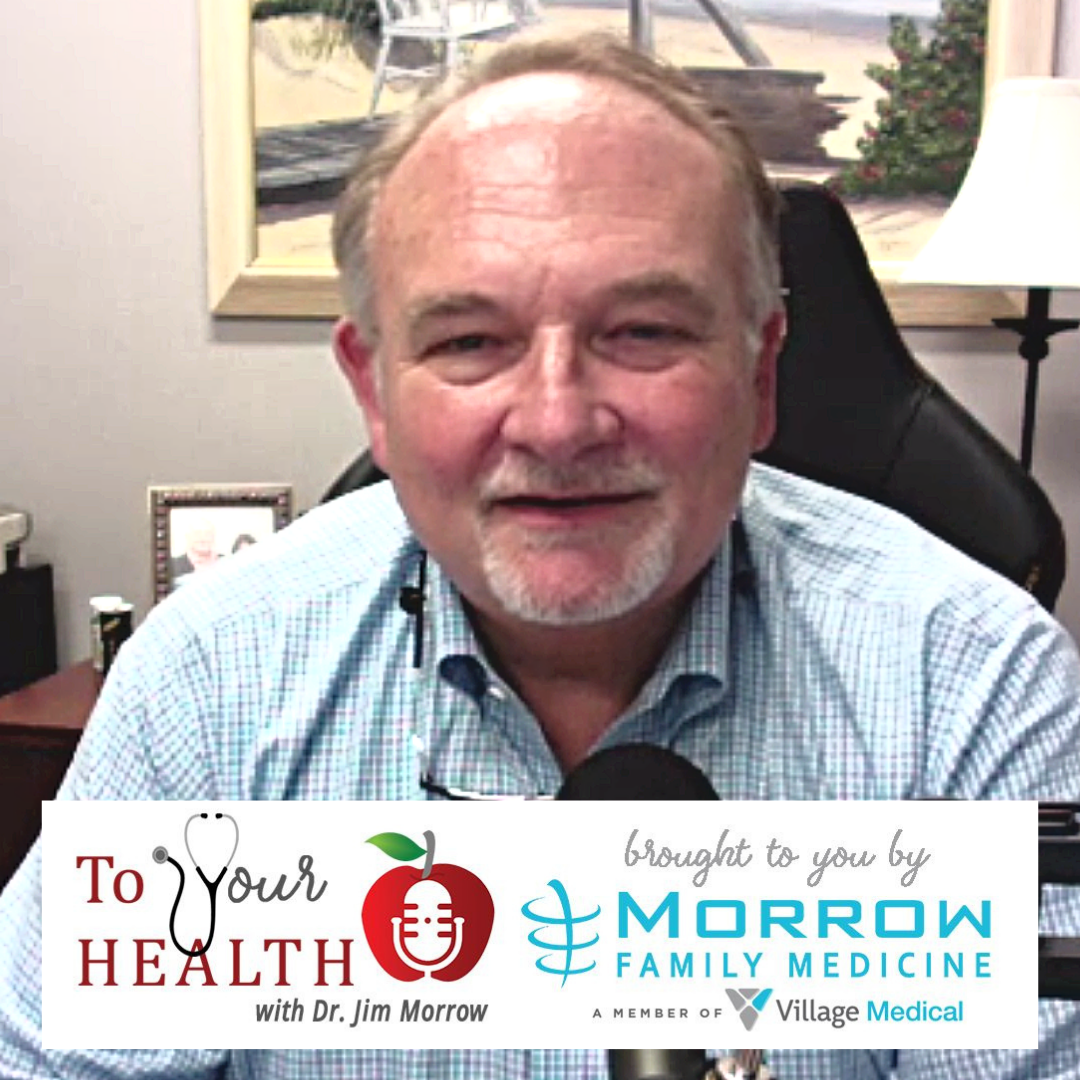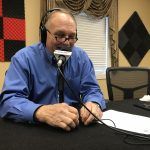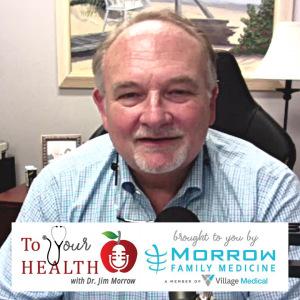
 Seasonal Affective Disorder (Episode 66, To Your Health with Dr. Jim Morrow)
Seasonal Affective Disorder (Episode 66, To Your Health with Dr. Jim Morrow)
Dr. Jim Morrow, Host of To Your Health, revisits Seasonal Affective Disorder (SAD). He discusses what causes it, how it is diagnosed, and how to treat it. He mentions light therapy, behavioral therapy, medication, and lifestyle changes, as well as advice for how to live with Seasonal Affective Disorder. To Your Health is brought to you by Morrow Family Medicine, a Member of Village Medical, which brings the care back to healthcare.
About Morrow Family Medicine, A Member of Village Medical
Morrow Family Medicine, a Member of Village Medical, is an award-winning, state-of-the-art family practice with offices in Cumming and Milton, Georgia. The practice combines healthcare information technology with old-fashioned care to provide the type of care that many are in search of today. Two physicians, three physician assistants and two nurse practitioners are supported by a knowledgeable and friendly staff to make your visit to Morrow Family Medicine, A Member of Village Medical one that will remind you of the way healthcare should be. At Morrow Family Medicine, a Member of Village Medical, we like to say we are “bringing the care back to healthcare!” The practice has been named the “Best of Forsyth” in Family Medicine in all five years of the award, is a three-time consecutive winner of the “Best of North Atlanta” by readers of Appen Media, and the 2019 winner of “Best of Life” in North Fulton County.
Village Medical offers a comprehensive suite of primary care services including preventative care, treatment for illness and injury, and management of chronic conditions such as diabetes, congestive heart failure, chronic obstructive pulmonary disease (COPD) and kidney disease. Atlanta-area patients can learn more about the practice here.
Dr. Jim Morrow, Morrow Family Medicine, and Host of To Your Health with Dr. Jim Morrow
 Dr. Jim Morrow is the founder and CEO of Morrow Family Medicine. He has been a trailblazer and evangelist in healthcare information technology, was named Physician IT Leader of the Year by HIMSS, a HIMSS Davies Award Winner, the Cumming-Forsyth Chamber of Commerce Steve Bloom Award Winner as Entrepreneur of the Year and he received a Phoenix Award as Community Leader of the Year from the Metro Atlanta Chamber of Commerce. He is married to Peggie Morrow and together they founded the Forsyth BYOT Benefit, a charity in Forsyth County to support students in need of technology and devices. They have two Goldendoodles, a gaggle of grandchildren and enjoy life on and around Lake Lanier.
Dr. Jim Morrow is the founder and CEO of Morrow Family Medicine. He has been a trailblazer and evangelist in healthcare information technology, was named Physician IT Leader of the Year by HIMSS, a HIMSS Davies Award Winner, the Cumming-Forsyth Chamber of Commerce Steve Bloom Award Winner as Entrepreneur of the Year and he received a Phoenix Award as Community Leader of the Year from the Metro Atlanta Chamber of Commerce. He is married to Peggie Morrow and together they founded the Forsyth BYOT Benefit, a charity in Forsyth County to support students in need of technology and devices. They have two Goldendoodles, a gaggle of grandchildren and enjoy life on and around Lake Lanier.
Facebook: https://www.facebook.com/MorrowFamMed/
LinkedIn: https://www.linkedin.com/company/7788088/admin/
Twitter: https://twitter.com/toyourhealthMD
The complete show archive of To Your Health with Dr. Jim Morrow addresses a wide range of health and wellness topics and can be found at www.toyourhealthradio.com.
Dr. Morrow’s Show Notes
What is Seasonal Affective Disorder?
- Seasonal affective disorder (SAD) is a type of depression that is triggered by the seasons of the year
- Symptoms usually begin in late fall or early winter
- People with SAD usually feel better in the spring and summer
- It is thought that SAD is related to changes in the amount of daylight during different times of the year
- Some people have SAD with depressive episodes in the summer instead of winter
- This is much less common
How common is SAD?
- Between 4% and 6% of people in the United States suffer from SAD
- Another 10% to 20% may experience it in a milder form
- SAD is more common in women than in men
- Some children and teenagers get SAD. But it usually doesn’t start in people younger than 20 years of age.
- The risk of SAD decreases for adults as they age
- SAD is more common in northern regions of the United States
- Winters are typically longer and harsher there
- There is also less sunlight because they are farther away from the equator
Symptoms of SAD
- Not everyone who has SAD experiences the same symptoms
- Common symptoms of winter-onset SAD include:
- change in appetite, especially craving sweet or starchy foods
- weight gain
- fatigue
- sleeping more than normal
- difficulty concentrating
- irritability and anxiety
- increased sensitivity to rejection
- avoidance of social situations
- loss of interest in the activities you used to enjoy
- feelings of guilt or hopelessness
- physical problems, such as headaches
- Common symptoms of winter-onset SAD include:
- Symptoms of summer-onset SAD include:
- loss of appetite
- weight loss
- insomnia
- irritability and anxiety
- agitation
- Symptoms of SAD tend to come back year after
- They usually come and go at about the same time every year
- If you think this could be happening to you, call your family doctor.
What causes SAD?
- In most cases, SAD seems to be related to the loss of sunlight in the fall and winter
- Researchers have found that reduced sunlight can affect the body in ways that could contribute to SAD. These include:
o Circadian rhythm (biological clock) –
- The decrease in sunlight could disrupt your body’s natural rhythms
- This could lead to feelings of depression
o Serotonin levels –
- Serotonin is a brain chemical that affects your mood
- Reduced sunlight could cause serotonin levels to drop
- This could trigger depression
o Melatonin levels –
- Melatonin is a brain chemical that regulates sleep
- More darkness causes the body to produce more melatonin
- More melatonin could make you feel more tired and lethargic
- These are common symptoms of depression
o Vitamin D levels –
- It is believed that vitamin D plays a role in serotonin levels
- Much of the vitamin D we get is from the sun
- Less sunlight could lead to a deficiency in vitamin D
- This can cause depression symptoms
Some people have a higher risk of developing SAD Factors that increase risk include:
o Being female.
- Four times as many women are diagnosed with SAD than men
o Living far from the equator.
- In the United States, living farther north increases your risk
- These areas get less sunlight in fall and winter
o Family history.
- Having family members with SAD or other forms of depression increases your risk
o Having depression or bipolar disorder.
- If you have one of these conditions, your symptoms may worsen with the seasons
o Young age.
- SAD is more common among younger adults
- It has been reported in teens and children
- Your chances of getting it decrease as you get older
How is SAD diagnosed?
- Your doctor will ask you about your symptoms, thoughts, feelings, and behavior
- He or she may perform a physical exam
- They may request lab tests to rule out other conditions that cause symptoms similar to SAD
- They may refer you to a specialist to diagnose your condition
- This could be a psychologist or a psychiatrist.
Can SAD be prevented or avoided?
- There’s not much you can do to avoid getting SAD
- But you can take steps to manage it so your symptoms don’t get worse
- Some people start treatment before their symptoms start
- They also continue treatment past the time that their symptoms normally go away
- Others need continuous treatment to control their symptoms
SAD treatment
- The three main ways SAD is treated are with light therapy, behavioral therapy, or medicine
- Your doctor may want to combine therapies if using one does not work for you
ï Light therapy
- Light therapy is designed to make up for the lack of sunlight during the fall and winter
- It has been used to treat SAD since the 1980s.
- You will sit in front of a special light box every
- The box emits a bright white light that mimics natural sunlight
- It seems to make a change in brain chemicals that regulate your mood
- The amount of time you sit in front of the light box depends on the strength of the light
- It is usually between 20 and 60 minutes
- There are other types of light therapy
- Instead of sitting in front of a box, you can wear a visor that emits light
- Another kind is a “dawn simulator”
- This light turns on early in the morning in your bedroom
- It mimics a natural sunrise and gradually increases in brightness
- This allows you to wake up naturally, without using an alarm
- If light therapy helps, you’ll continue it until enough sunlight returns
- This usually happens in spring
- Stopping light therapy too soon can result in a return of symptoms
- When used properly, light therapy seems to have very few side effects
- Some side effects include eyestrain, headache, fatigue, and irritability
- If you use it too late in the day, you could have trouble sleeping
- Talk to your doctor before starting light therapy if you have:
- bipolar disorder
- skin that is sensitive to sunlight
- conditions that make your eyes vulnerable to sunlight
- Tanning beds should not be used to treat SAD
- The light sources in tanning beds are high in ultraviolet (UV)
- These harm your eyes and your skin
- They also cause skin cancer
- The light sources in tanning beds are high in ultraviolet (UV)
ï Behavioral therapy
- Talk therapy or behavioral therapy can help you identify negative thoughts
- Then you replace those with more positive thoughts
- Therapy can help you learn healthy ways to manage your symptoms of SAD
- You can also learn how to manage stress
ï Medicines
- Your doctor might recommend you take medicine to help with your symptoms, especially if they are severe
- Selective Serotonin Reuptake Inhibitors (SSRIs) are often used to treat depression
- Some have been approved to treat SAD specifically
- You may have to take the medicine for several weeks before you feel
- You may have to try more than one medicine to find the one that works best for you
- You can also make lifestyle changes that can help your symptoms
- Let as much natural light as possible into your home or
- Open blinds, sit close to windows, and keep your environments as bright as possible
- Get outside when you
- Even if it’s cold or cloudy, the light can still benefit
- Keep physically active
- Exercise and activity boost endorphins and relieve stress
- Both of these can keep you feeling better
Living with SAD
The keys to living with SAD are to plan ahead and to manage your symptoms.
ï Follow your treatment plan.
- This includes going to appointments, taking medicines, and following up if things aren’t working
ï Take care of your body.
- Eat healthy foods and get enough sleep
- Exercise has been shown to have the same effect on depression as antidepressants
ï Have a plan.
- Know what you will do when your depression symptoms start to get worse
- Watch for early signs and take action before you feel bad
ï Don’t turn to alcohol or drugs.
- They make depression worse
- They can also have negative reactions with antidepressants
ï Manage stress.
- You can’t avoid stress, so you have to learn to manage it
- Talk to a counselor or read about ways to handle stress better
ï Don’t isolate.
- It’s harder to be social when you’re depressed
- But being alone can make you feel worse
- Try to reach out as much as you can
ï Start treatment early.
- If you know your symptoms usually start in October, start your treatments in September, before symptoms start
- You might be able to prevent. them
ï Plan ahead.
- Some people purposely plan their lives to be very busy during the time they normally feel down
- This helps prevent them from “hiding out” at home, because they have already made committments
ï Take a trip.
- Plan a trip to a warmer, sunnier climate during the winter
- The positive feelings will extend before, during, and after your trip
 Seasonal Affective Disorder (Episode 66, To Your Health with Dr. Jim Morrow)
Seasonal Affective Disorder (Episode 66, To Your Health with Dr. Jim Morrow)













